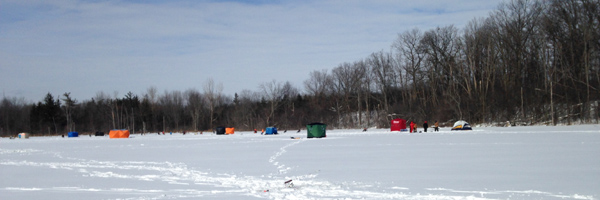A recent video from James Holst and Jon Marshall on In Depth Outdoors TV got me thinking about general seasonal timing as it relates to ice fishing. In the video Holst talks about how walleye fishing tends to slow down mid-winter and perch seem to turn on later in the season. However cold (and deep) water species like rainbow and lake trout tend to be active throughout the ice season.
Further dissection of the ice fishing season seems to be in order. Tim Allard [1] divides the rainbow fishing season as follows. First ice – shallow bays and shorelines mixed with healthy weeds, areas that will hold baitfish and aquatic insects. Mid-winter – deeper areas with sharp breaks and reefs and areas where fish are suspended off structure. Late ice – again back to shallower areas, shoreline rock structures, walls, boulder pile and points.
As it is in open water season, timing also plays a major role in ice fishing success.
For walleye, Scott Glorvigen [2] suggests that the season splits in two. For early ice, fish are set up in deep water close to major structures – flats with points, sharp drop-offs with rock and gravel, both adjacent to the main lake deep water. Note that fish may move shallow as evening sets in. For late ice, walleye are moving to pre-spawn areas (staging areas for spawning grounds). Look for a connecting river or stream (warmer water inflows) and gravel shorelines. Pressure ridges in the ice (ice build-ups) can also concentrate bait fish (the ridge makes structure below the ice as well as above it) and can be good areas to try.
Gord Pyzer [3] also suggests that looking at ice as one big season is a serious mistake. For first ice (November/December in Northern Ontario) its best to think of the fish still being in areas that they were at in late fall open water season. As time moves to mid-winter (February) walleye, pike, perch and crappie are now concentrated in their wintering home ranges. The “February doldrums” (i.e. the slow down in walleye fishing Holst describes) can be a result of a couple of phenomena. Firstly, many fish are in a conserve energy type of mode with some (such as muskie, largemouth and smallmouth bass) being in a near hibernation state of torpor. Secondly, many lakes are now starting to experience increasing oxygen loss (see previous post). This will also cause a decrease in fish energy and movement. Gord suggests slowing down lure presentations significantly (even dead sticking) during this time period.
(On a side note, if you’re looking to hear for someone with an amazing amount of fishing knowledge, I highly recommend following Gord Pyzer on twitter @gordpyzer)
As it is in open water season, timing also plays a major role in ice fishing success.
References:
[1] Ontario Fishing Network E-Magazine (www.ontariofishing.net) Volume 9, Issue 1 – Jan. 2009 #97.
[2] Charlie Moore with Scott Glorvigen “Seasonal Movements Equals Winter Walleyes”, http://www.northlandtackle.com/
[3] Gord Pyzer, “Adopt this tried and true game plan for beating the February ice fishing blues”, http://northernontario.travel/fishing/adopt-this-tried-and-true-game-plan-for-beating-the-february-ice-fishing-blues#



